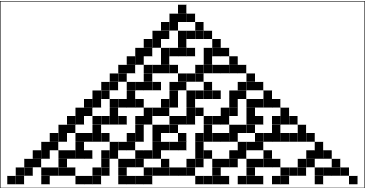Game of Comparch
An exploration and implementation of cellular automata and computing for Olin College Computer Architecture FA18.
View the Project on GitHub anushadatar/game-of-comparch
Overview
Mathematical Representations and Computational Implications of Cellular Automata
Cellular Automata as a Computing Platform
Conway's Game of Life
Our Implementation
References
Game of CompArch: Cellular Automata and Computing
An exploration of the use of cellular automata to perform complex computations, culminating in the implementation of an Arithmetic Logic Unit (ALU) in John Conway’s Game of Life.
Cellular automata generally have computing applications in very specific problem spaces, such as modelling discrete physical systems and visualizing complex patterns evolving over time. However, some cellular automata have been proven to be Turing-complete and theoretically able to create Universal Turing machines, showing that cellular automata may even have uses in computing in a more traditional sense. In this project we’ve compiled a write-up and presentation that serve as an introduction to cellular automata and their uses, as well as constructing our own computational unit in a well-known cellular automata, the Game of Life. This demonstrates that analogues to more familiar computational elements can be effectively made in a simple cellular automata, though these systems are not tailored to these methods of computation.
Here is a link to a Slide Deck with visualizations and information about our project and implementation.
Introduction to Cellular Automata
Cellular automata are spatially- and temporally-discrete systems that develop through a serious of time steps according to a set of rules. These rules are constrained in that a cell can only be affected by a neighboring cell (no action at a distance) and all the rules must be abstract and able to be described purely mathematically. Because of this, cellular automata are typically computational systems that can sometimes be shown to be Turing-complete.
One of the simplest examples of cellular automata is a one-dimensional system with each cell assuming a state of either “on” (black) or “off” (white). Let’s say it follows a set of rules like the ones shown below, where the second-row cell shows the evolution resulting from the top-row condition when following these rules.

The image below shows this configuration iterating through many time steps. You can see that, even a one-dimensional system with an initial condition of one “on” block results in intricate patterns over time! This particular pattern is used in Mathematica as a large-integer random-number generator due to the aperiodic, chaotic behavior that it exhibits.

Cellular automata have also become a topic of philosophical discussion, as the complex emergent patterns in cellular automata raise questions about emergent theories of the origins of life and a computational universe’s relationship with determinism.
The Game of Life

Proposed by John Conway in 1970, the Game of Life is now one of the most well-known cellular automata systems ever created.
The Game of Life is a 2-dimensional binary system with a Moore neighborhood. At each time step, the cells can take one of three actions:
- Survival: If the cell was on and either two or three neighbors were on, the cell remains on
- Birth: If the cell was off and exactly three of its neighbors were on, the cell turns on
- Death: If the cell was on and fewer than two or more than three neighbors were on, the cell turns off
These simple rules give rise to many observable complex behaviors. A small community built itself around Conway’s Game of Life, exploring the useful stable configurations that arise from certain starting conditions. Commonly used objects include blinkers that repeat their states after a certain number of time steps, gliders that travel across the grid, or guns that generate a stream of gliders. Configurations can become incredibly complex, with large starting configurations resulting in stunning evolutions that almost seem to be alive.

Philosopher Ilachinski, well known for his work in the field of cellular automata, says about this features of the Game of Life
Upon observing the seemingly unlimited complexity and variety of Life’s evolving patterns, it becomes almost impossible to refrain from imagining, along with Conway, that, were the game really to be played on an infinite lattice, there must surely arise true living “life forms”, perhaps themselves evolving into more complex, possibly sentient, “organisms”.(Ilachinski 2001: 133)
Using the pattern configurations that have been discovered by users of the Game of Life, we can create basic computational elements. With streams of gliders representing logical 1’s and 0’s, all the basic logic gates can be made, such as the AND gate shown below.
By showing that these building blocks of computation can be made robustly and consistently, it seems as if any computation that can be performed by a traditional computer could theoretically be implemented in the Game of Life. In fact, Life has been proven to be Turing-complete, and Paul Rendell made it definitive by creating the first Turing machine ever constructed in the Game of Life.